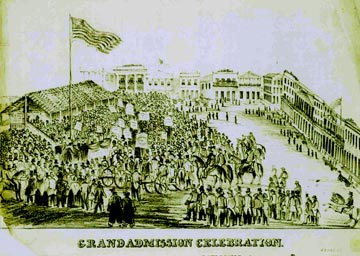Stanford Mansion Celebration 2005

California officially became a state in 1850, and situated its first capital in San Jose. The city did not have facilities ready for a proper capital, and the winter of 1850 - 1851 was unusually wet, causing the dirt roads to become muddy streams. The legislature was unsatisfied with the location, so former General and State Senator Mariano Guadalupe Vallejo donated land in the future city of Vallejo for a new capital; the legislature convened there for one week in 1852 and again for a month in 1853. Again, the facilities available were unsuitable to house a state government, and the capital was soon moved three miles away to the little town of Benicia, inland from the San Francisco Bay. The strait links San Pablo Bay to Grizzly and Suisun Bays deep in the interior. A lovely brick statehouse was built in old American style complete with white cupola. Although strategically sited between the Gold Rush territory of the Sierra Foothills and the financial port of San Francisco, the site was too small for expansion, and so the capital was moved further inland past the Sacramento River Delta to the riverside port of Sacramento.
Sacramento was the site of John Sutter's large farm and his fort. The town was founded by John Sutter, Jr. while the elder Sutter was away, at the river's edge and downhill from the fort. Sutter Sr. was indignant since this place, shaded by water-needy Cottonwood trees, was often under water. Indeed, every hundred years or so, the whole Great Valley from Chico to Bakersfield, was one great freshwater sea. However, lots were already sold, so there the town of Sacramento stayed. At the end of the century, the streets were raised a full story, so buildings in Old Town are now entered through what were once doors to the balconies shading the sidewalks below
Historic Gold Spike Display
Mansion Vignettes
